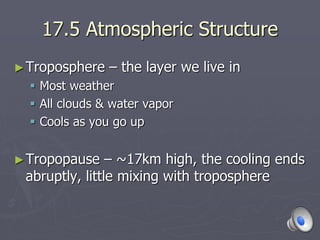
HPU NCS2200 Chapter17& 18 primary atmosphere structure and function
- 1. 17.5 Atmospheric Structure ►Troposphere – the layer we live in Most weather All clouds & water vapor Cools as you go up ►Tropopause – ~17km high, the cooling ends abruptly, little mixing with troposphere
- 2. 17.5 Atmospheric Structure ►Stratosphere – temp constant to 35km Increases up to 50km Ozone forms here Above 55km (stratopause) temps fall again ►Mesosphere – thin air, very cold up to 80km ►Thermosphere – above 80km, temps rise rapidly (to just below freezing!) Hi-energy environment
- 4. 18.1 Incoming solar radiation ►Light – behaves like a wave and a particle Photons – elementary particles of light Electromagnetic radiation – light also behave as energy waves, perpendicular electrical and magnetic waves ►Wavelength – distance between wave crests ►Frequency – number of waves passing a point/sec. ►Electromagnetic spectrum – continuum of electromagnetic wavelengths
- 5. 18.1 Incoming solar radiation ►Absorption – when something absorbs radiation, the photon’s energy can initiate chemical and/or physical reactions Excited state – absorbed photons makes electrons get “excited” Emission of radiation – when the exited electrons “settle down” they emit light ►All objects emit some radiation ►Emission color (wavelength) relates to temperature
- 6. 18.1 Incoming solar radiation ►Reflection –electromagnetic radiation bouncing from a surface Albedo – proportional reflectance of a surface ►(e.g.: a perfect mirror would have an albedo of 100%) ►Glaciers & snowfields approach 80-90% ►Clouds – 50-55% ►Pavement and some buildings – only 10-15%
- 8. Fig. 18.5, p.455 ► Scattering – gases and water droplets scatter light in all directions short “blue” wavelengths scatter more, so skies are blue
- 9. 18.2 the radiation balance ►Earth’s surface absorbs light energy Most is re-emitted, mainly as heat Greenhouse effect – some gases and water vapor absorb some of this heat ►Dust, clouds, aerosols, particulates all affect atmospheric temperature Hi-altitude dust can reflect light Lo altitude particles can absorb heat
- 10. Fig. 18.6, p.455
- 11. 18.3 Energy storage & transfer – climate’s driving mechanism ►Temperature – is proportional to the average speed of atoms or molecules in a sample. E.g.: hot water molecules move faster than cold water molecules ►Heat – is a measure of the total energy in a sample average energy X number of molecules E.g.: bathtub of ice has more heat than a cup of tea
- 12. 18.3 Energy storage & transfer – climate’s driving mechanism ►Conduction – transfer of heat by direct collisions of molecules Heat, good conductor; air, poor conductor ►Convection – transfer of heat by the motion of a fluid medium ►Advection - horizontal air flow (meteorological term)
- 13. Fig. 18.8a, p.457 Convection example: heat from a stove heating a room
- 14. Fig. 18.8b, p.457 Convection within the atmosphere
- 15. p.459 Recall that the Earth is curved And lines of Latitude Are horizontal to the Equator and increase in Degrees from 0 to 90
- 16. 18.4 temperature changes with latitude & season ►Temperature decreases as latitude increases Light strikes more directly at low latitudes ►more energy per unit area, heats more effectively At high latitudes, the sun strikes quite obliquely ►At some point during the year at poles, it doesn’t strike at all
- 19. 18.4 temperature changes with latitude & season ►The seasons – related to orbital parameters Earth’s axis is tilted. During northern summer, the light hits more directly and in winter less so Tropics – the latitudes of 23.5o N/S are where light his directly on summer and winter solstice Equinox, when an area gets 12 hours each of light and dark ►On average, all areas of the globe receive the same sunlight time annually
- 21. 18.5 Temperature changes with geography ►Altitude – temperature decreases with altitude ►Ocean effects – land heats more quickly than water, so inlands see greater temperature extremes Currents often transfer heat to moderate temperatures (e.g.: the Gulf Stream)
- 22. 18.5 Temperature changes with geography ►Cloud cover and albedo Clouds intercept light energy ►They cool during day by blocking the sun Clouds have high albedo, turning incoming energy back towards space ►Then warm at night by trapping ground-emitted heat Clouds have high albedo, turning outgoing energy back to ground ►Snow effects solar input in similar fashion, it is reflective while soil/rock is not